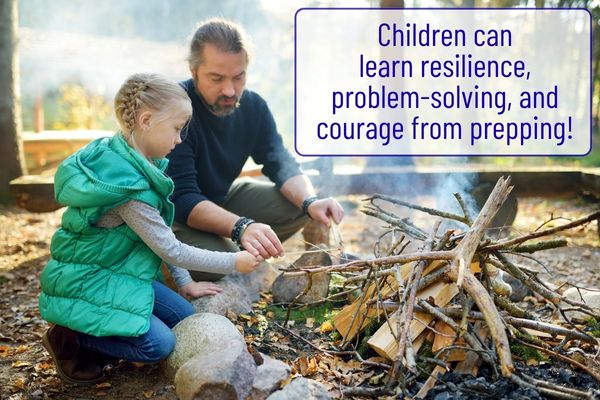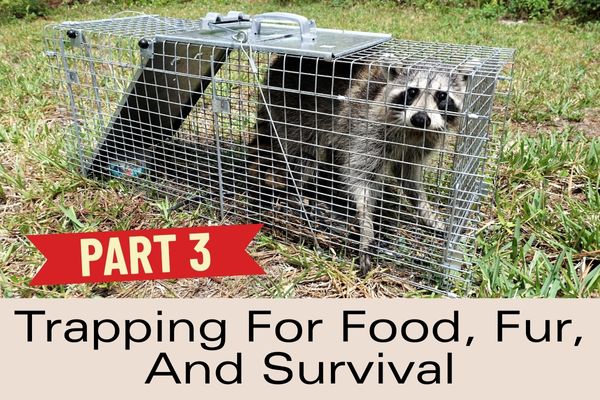Disaster prepping with a family, especially with kids, involves more than stockpiling supplies.
It’s about building resilience, teamwork, and readiness across all age levels. Here’s a breakdown of the fundamentals every family prepper should know, divided into practical categories:
Age-Appropriate Education
Peppers must teach their children survival skills in age-appropriate ways:
Young kids might learn how to recognize danger (fire, strange smells, loud alarms), memorize emergency contacts, and understand “safe spots” in the home.
Older kids might get hands-on with basic first aid, fire-starting techniques, filtering water, map reading, and self-defense techniques or martial arts.
Teens might be taught how to use tools, learn higher level martial arts, use firearms, manage supplies, or help lead in an emergency.
The goal is to gradually build comfort with self-reliance without overwhelming them.
Routine Drills
Instead of just talking about what to do, serious peppers must practice it. That can mean: Fire drills, Evacuation route walk-throughs, Shelter-in-place scenarios (like staying indoors during storms or chemical spills).
These drills help kids stay calm in real-life situations because the motions are already familiar.
Psychological Resilience
Peppers work on more than just gear; they focus on mindset. That includes:
:: Teaching children how to stay calm under pressure
:: Helping them talk through fears without becoming paralyzed by them
:: Encouraging problem-solving and self-trust (“What would you do if…?”)
Books, stories, or even games with survival themes are often used to spark discussion and reflection.
Empower Through Responsibility
Preppers often give children real roles in the family preparedness plan. Here are just a few:
One child might be in charge of keeping the first aid kit stocked. Another might be the “navigator” who learns routes on a map. A teen might manage the family’s radio communications or learn how to operate a generator. This sense of ownership builds pride and capability.
Gear Training
Peppers shouldn’t just store gear in a cold cellar and wait. They must proactively teach their kids how to use it:
:: Flashlights, radios, walkie-talkies
:: Fire starters and camp stoves
:: Knives, multitools, or bows (when age-appropriate and safe)
:: Water filtration systems or food prep kits
Children might even carry their own scaled-down bug-out bags with food, clothes, first aid items, and copies of important documents.
Community and Communication Plans
Kids can be taught who to contact and where to go if separated. This may include:
:: “Meet-up points” if the family is split during a crisis
:: Family code words for distress
:: How to call 911 or use radios if phones are down
Redundancy in planning could be helpful: knowing multiple ways to connect or reach safety.
Exposure to Nature
Many peppers raise kids who are comfortable outdoors:
:: Hiking, camping, and foraging
:: Identifying edible or medicinal plants
:: Building shelters or navigating with a compass
This isn’t just about survival. It’s about confidence in the natural world, away from screen-based activities.
What is “Systemic Risk”?
Advanced peppers will also teach kids to be alert to systemic risk … how governments respond to emergencies, what local vulnerabilities exist, and what kinds of disruptions are most likely (floods, outages, civil unrest, etc.).
This could involve:
:: Analyzing past disasters together
:: Reading current events with a prepper lens
:: Encouraging healthy skepticism without falling into paranoia
Team-Based Mindset
Peppers emphasize family unity and mutual aid. Children can be taught:
:: How to help younger siblings
:: The value of watching out for neighbors
:: Why it’s important to share responsibility
Even if things get chaotic, the family system holds.
Daily Life as Training
A lot of prepper parenting is subtle and woven into regular life:
:: Cooking from scratch (food preservation, bulk storage)
:: Learning old-fashioned skills (sewing, tool use, gardening)
:: Limiting dependency on tech or fragile infrastructure
To outsiders, it may just look like a self-reliant and mutually-engaged family life. But to peppers, it’s long-term resilience training.
In short, peppers raise kids to be calm, capable, and adaptable without making them afraid of the world. It’s about preparation, not panic, and fostering a mindset that says: “We’ve thought about what could happen, and we’re ready for it together.
Child-focused prepping isn’t just about teaching survival skills. It’s about making preparedness feel natural, empowering, and even fun for children. When kids feel like they’re part of the team, they’re more likely to stay calm, contribute, and make smart decisions during a real emergency.
Here’s a detailed guide to child-focused prepping that includes your children in meaningful, age-appropriate ways:
>> Create a Sense of Purpose, Not Panic
Start by framing prepping in a positive light:
:: It’s about being ready, NOT being afraid.
:: It’s about helping family, not being helpless.
:: It’s like practicing for a game, a storm, or a camping trip … normal, not doomsday.
Avoid scary language. Focus on building confidence, problem-solving, and the “we got this” mentality.
Make Them Part of the Planning
Even young children can help with:
:: Packing their own bugout-bag: Let them choose a comfort item, snacks, and flashlight. You can quietly double-check for essentials.
:: Choosing rally points: Ask, “If something happened while we were at the park, where would we meet?”
:: Making emergency cards: Let them decorate laminated contact cards or ID tags.
:: Role-playing scenarios: Act out “What would you do if…” situations together like mini adventures.
When children help create the plan, they remember it better and they feel like it’s theirs.
3. Give Each Child a Role
Giving a child a responsibility makes them feel important. Some role examples:
:: Navigator: Learns how to use maps or recognize landmarks.
:: Medic Assistant: Helps check or refill the family’s first-aid kit.
:: Radio Operator: Learns how to use a walkie-talkie.
:: Signal Expert: Practices mirror signaling, whistle codes, or flashlight patterns.
:: Safety Buddy: Looks after a younger sibling or pet.
These roles can rotate, and you can give them a badge, sticker, or patch to make it feel more official.
Create a Kid-Friendly Go Bag
Every child should have their own go-bag (bugout bag), ideally lightweight and personalized. It should include:
:: Change of clothes
:: Snacks and a water bottle
:: Flashlight or glowstick
:: Emergency whistle
:: Small toy or comfort item
:: Photo of family members
:: Laminated card with names, addresses, and phone numbers
:: Pencil and notepad
:: First-aid basics (Band-Aids, antiseptic wipes)
:: A fleece blanket or emergency space blanket
Let them help pick items and pack it. Do regular “go-bag check days” to keep things fresh and let them stay involved.
Turn Skill-Building into Play
Kids learn best when they’re engaged and having fun. Conveniently, various things already in the canon of childhood play can be repurposed to teach prepping skills. For example, obstacle courses can teach fitness and agility. Scavenger hunts can teach map reading and navigation. Camping trips can help kids practice shelter building and fire safety. Treasure hunts can reinforce hiding spots for gear or caches. Storytelling can teach decision-making through imaginary scenarios. Rather than rerouting or uprooting your children’s lives to prepare them for disaster, their safety can exist in harmony with the usual activities of childhood.
But to maintain this “playful” relationship to prepping that can blossom into correct procedure when the time is right, parents must:
Build Prep Into Daily Routines
The more you normalize prepping, the less scary it feels. Below are some more ideas of how to integrate your child’s knowledge of prepping with your own:
:: Practice cooking shelf-stable meals together.
:: Let kids help rotate food or water storage.
:: Have them test batteries in flashlights or radios.
:: Practice short “no-power” nights with candles and board games.
:: Show how to purify water or grow food in the yard or windowsill.
These habits can become weekly chores, family challenges, or after-school projects.
Be Emotionally Ready
In prepping, mindset matters. Help your children learn to:
:: Breathe and stay calm during stressful situations.
:: Talk through fear instead of shutting down.
:: Ask for help confidently when needed.
:: Recognize and avoid unsafe people or situations.
You can even practice calming techniques like counting breaths, visualization, or “grounding” exercises to help manage panic in real emergencies.
Have Regular “Prepper Family Time”
Schedule one night a month for:
:: Reviewing the family emergency plan
:: Checking or rotating supplies
:: Watching a survival video or reading a prepping story
:: Playing a scenario-based board game (like Survive: Escape from Atlantis! or Forbidden Island)
These check-ins keep the plan fresh and remind the children that prepping is ongoing, not a one-time event.
Celebrate the Mindset
A child who feels capable is a child who feels safe. Celebrate prepping as part of their identity:
:: “You’re the kind of kid who knows how to take care of things.”
:: “You’re the one who remembered to grab the flashlight … good job.”
:: “You’re a helper when things go wrong.”
This encourages resilience, problem-solving, and courage, not just knowledge.
In the end, prepping with children isn’t about fear … it’s about awareness. When families include children in preparedness from the start, they do more than create a safety plan. They create young people who know how to act, adapt, and help when it counts. Weaving preparedness into daily life(through play, routine, conversation, and responsibility) let’s parents nurture kids who are ready for emergencies. They’re empowered to meet them with clarity, care, and courage.
Because when the unexpected happens, it’s not just about the gear. It’s about the mindset. Prepared children won’t freeze, fear, or falter. They’ll look to you, look to each other, and say:
“We got this.”




